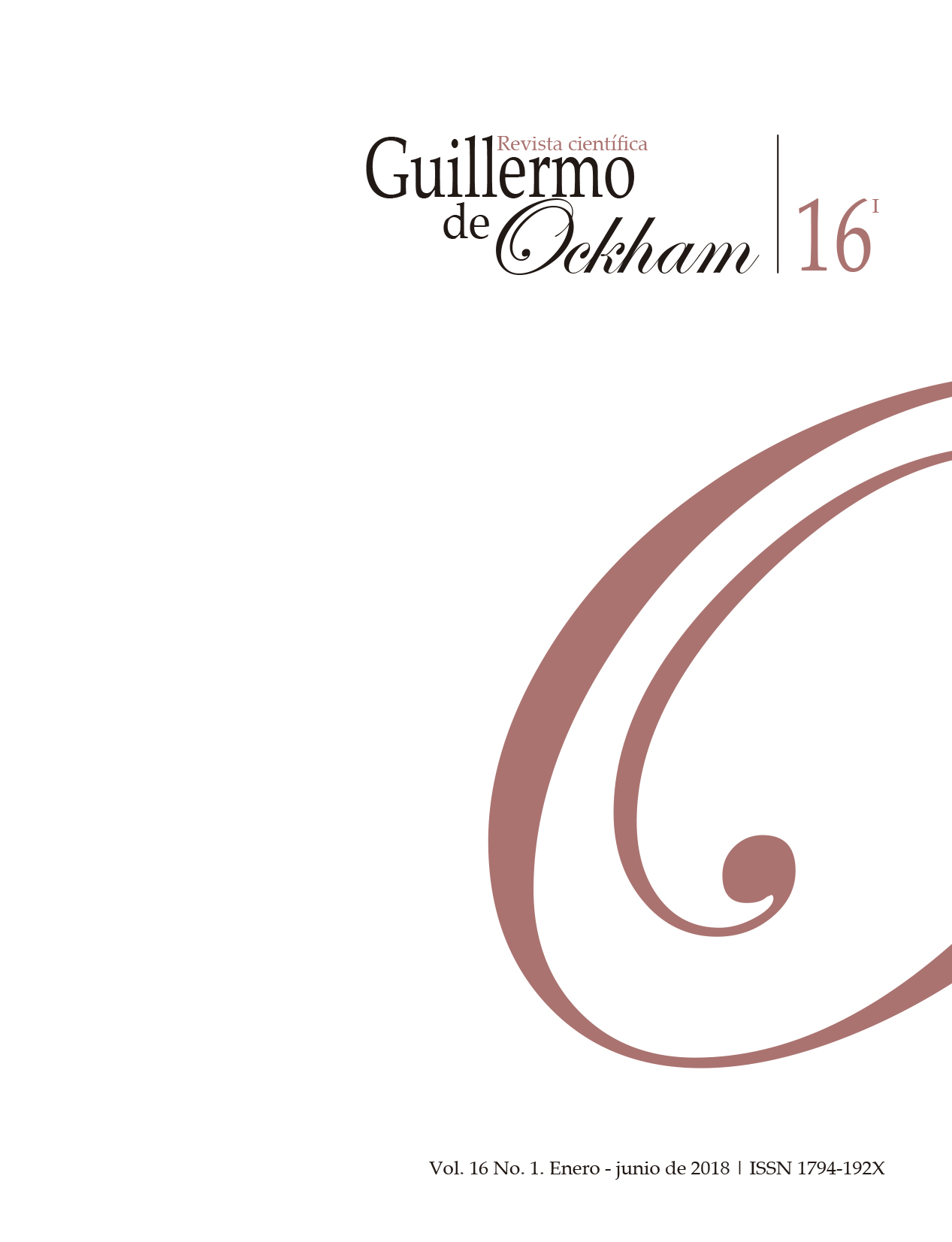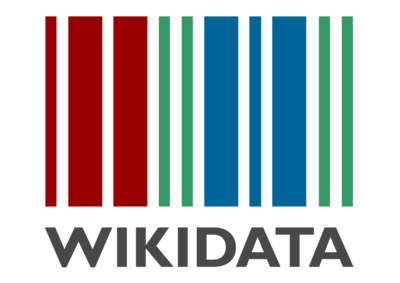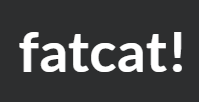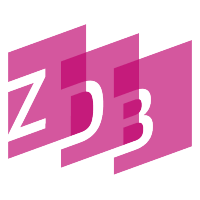La Revista Guillermo de Ockham brinda un acceso inmediato y abierto a su contenido, basado en el principio de ofrecer al público un acceso gratuito a las investigaciones para brindar un intercambio global de conocimiento. A menos que se establezca lo contrario, el contenido de esta revista tiene una licencia con Creative Commons Attribution-NonCommercial-NoDerivatives 4.0 International (CC BY-NC-ND 4.0) http://creativecommons.org/licenses/by-nc-nd/4.0/
- Atribución: debe otorgar el crédito correspondiente, proporcionar un enlace a la licencia e indicar si se realizaron cambios. Puede hacerlo de cualquier manera razonable, pero no de ninguna manera que sugiera que el licenciante lo respalda a usted o su uso.
- No comercial: no puede utilizar el material con fines comerciales.
- Sin derivados: si remezcla, transforma o construye sobre el material, no puede distribuir el material modificado.
- Sin restricciones adicionales: no puede aplicar términos legales o medidas tecnológicas que restrinjan legalmente a otros de hacer cualquier cosa que permita la licencia.
Resumen
Academic writing is an essential skill that language students need to develop at tertiary education. This article intends to be a contribution to teaching academic writing having Genre Theory as a framework so that students are able to use different texts depending on their communicative end. Students were asked to write a narrative at the end of the semester. This article shows the main difficulties students have to write this text type in a language subject at tertiary education and the main aspects they do well following the characteristics of the genre. The analysis shows that students have difficulties with the use of transitions, verb tenses and lexical cohesion. We intend to highlight that making explicit the formal and structural characteristics of the genres contributes to facilitate that students are able to see a clear connection between the characteristics of a particular text type, in this case narrative, and its function in context.
Palabras clave:
Referencias
Butt, D., Fahey, R., Spinks, S & Yallop, C. (2000). Using functional grammar. An explorer’s guide. (2 ed.). Sydney: NCELTR.
Butt, D., Fahey, R., Feez, S., & Spinks, S. (2012). Understanding functional grammar. An explorer's guide. (3 ed.). Melbourne: Palgrave Macmillan.
Coffin, C. & Donohue, J.P. (2012). Academic Literacies and systemic functional linguistics: How do they relate? Journal of English for Academic Purposes, 1, 64–75.
De Silva Joyce, H. & Feez, S. (2012) Text-based language and literacy education: programming and methodology. Sydney: Phoenix Education.
Droga, L. & Humphrey, S. (2003). Grammar and meaning. An introduction for primary teachers. Berry NSW: Target Texts.
Edelsky, C. (2006). Literacy and justice for all: rethinking the social in language and education (language, culture, and teaching). (3 ed.). London: Lawrence Erlbaum Associates.
Fang, Z., & Schleppegrell, M. J. (2010). Disciplinary literacies across content areas: Supporting secondary reading through functional language analysis. Journal of Adolescent & Adult Literacy, 53, 587–597.
Fecho, B. (2011). Teaching for the Students. Habits of heart, mind, and practice in the engaged classroom. New York/London: Teachers College Press.
Gardner, S. (2012). Genres and registers of student report writing: An SFL perspective on texts and practices. Journal of English for Academic Purposes 11, 52–63.
Halliday, M.A.K (1978). Language as social semiotic: the social interpretation of language and meaning. London: Edward Arnold.
Herrington, A., Hodgson, K. & Moran, C. (eds.) (2009). Teaching the new writing. Technology, change and assessment in the 21st century classroom. New York/London: Teachers College Press.
Hsien-Chin, L. (2000). Assessing learner strategies using computers: new insights and limitations. CALL, 13(1), 65-78.
Hua, Z., Seedhouse, P., Li, W. & Cook, V. (2007). An Introduction. In Z. Hua , P. Seedhouse, W. Li & V. Cook (Eds.) Language learning and teaching as social inter-action (pp. 1-5). London: Palgrave Macmillan.
Hubbard, P. & Levy, M. (2006). The scope of CALL education. In P. Hubbard & M. Levy (Eds.), Teacher education in CALL (pp. 3-20). Amsterdam/Philadelphia: John Benjamins.
Klein, P. & Unsworth, L. (2014). The logogenesis of writing to learn: A systemic functional perspective. Linguistics and Education, 26, 1– 17.
Klein, P. D., & Yu, A. M. (2013). Best practices in writing to learn. In S. Graham, C. A. MacArthur & J. Fitzgerald (Eds.), Best practices in writing to learn (2 ed., Vol. 5, pp. 166–189). New York: The Guilford Press.
Martin, J.R. & Rose, D. (2012). Learning to write/learning to learn: genre, knowledge and pedagogy in the Sydney School. London: Equinox.
Martínez Lirola, M. (2006). The importance of teaching Systemic Functional Linguistics and Text Linguistics to improve writing in Bilingual Education Programs in the USA. Porta Linguarum. Revista Internacional de Didáctica de las Lenguas Extranjeras, 5, 139-150.
Martínez Lirola, M. (2013). Teaching visual grammar and social issues in an English language course: an example using multimodal texts on immigrant minors from a Spanish newspaper”. In F.J. Díaz Pérez, M.B. Díez-Bedmar, P. García-Ramírez & D. Rascón-Moreno (Eds.) Global issues and the teaching of language, literature and linguistics. (pp. 195-215) Viena: Peter Lang.
Martínez Lirola, M. & Tabuenca Cuevas, M. (2008). Integrating CALL and Genre Theory: a proposal to increase students’ literacy. RECALL, 20(1), 67-81.
Martínez Lirola, M. & Tabuenca Cuevas, M. (2010). Applying Genre Theory to improve exposition-type essay writing. Porta Linguarum. Revista Internacional de Didáctica de las Lenguas Extranjeras, 13, 29-42.
Moyano, E. I. (2013). (coord) Aprender Ciencias y Humanidades : una cuestión de lectura y escritura. Aportes para la construcción de un programa de inclusión social a través de la educación lingüística. Buenos Aires : Universidad Nacional de General Sarmiento.
Parodi, G. (2010). Written discourse genres. Towards an integral conception from a sociocognitive perspective. In G. Parodi (Ed.) Academic and Professional Discourse Genre in Spanish (pp. 17-35). Amsterdam/ Philadelphia: John Benjamins.
Pérez Gutiérrez, M. & Pérez Torres, I. (2005). Audio-visual resources and new technologies in ELT. In D. Madrid, N. Mclaren & A. Bueno (Eds.), TEFL in Secondary Education (pp. 545-578). Granada: Universidad de Granada.
Schleppegrell, M. J. (2011). Supporting disciplinary learning through language analysis: Developing historical literacy. In F. Christie, & K. Maton (Eds.), Disciplinarity: Functional linguistic and sociological perspectives (pp. 197–216). London: Continuum International Publishing Group.
Swales, J.M. (2002). On models of applied discourse analysis. In C.N. Candlin (Ed.), Research and Practice in Professional Discourse (pp. 61-77). Hong Kong: City University of Hong Kong Press.
Wennerstrom, A. (2003). Discourse analysis in the language classroom. Vol. 2. Genres of Writing. Michigan: The University of Michigan Press.
Wingate, U. (2012). Using academic literacies and genre-based models for academic writing instruction: A ‘literacy’ journey. Journal of English for Academic Purposes, 11, 26–37.
































